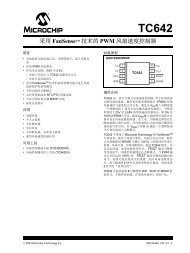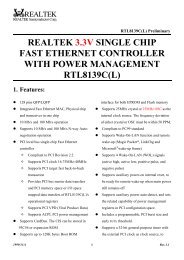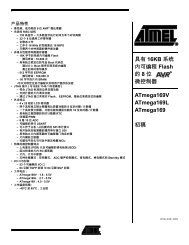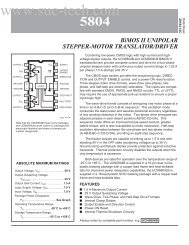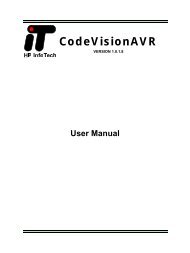Nios II Processor Reference Handbook
Nios II Processor Reference Handbook
Nios II Processor Reference Handbook
Create successful ePaper yourself
Turn your PDF publications into a flip-book with our unique Google optimized e-Paper software.
Functional DescriptionThe timer core has two user-visible features:■■The Avalon interface that provides access to six 16-bit registersAn optional pulse output that can be used as a periodic pulsegeneratorAll registers are 16-bits wide, making the timer compatible with both 16-bit and 32-bit processors. Certain registers only exist in hardware for agiven configuration. For example, if the timer is configured with a fixedperiod, the period registers do not exist in hardware.The basic behavior of the timer is described below:■■■■■■An Avalon master peripheral, such as a <strong>Nios</strong> <strong>II</strong> processor, writes thetimer core’s control register to:● Start and stop the timer● Enable/disable the IRQ● Specify count-down once or continuous count-down modeA processor reads the status register for information about currenttimer activity.A processor can specify the timer period by writing a value to theperiod registers, periodl and periodh.An internal counter counts down to zero, and whenever it reacheszero, it is immediately reloaded from the period registers.A processor can read the current counter value by first writing toeither snapl or snaph to request a coherent snapshot of the counter,and then reading snapl and snaph for the full 32-bit value.When the count reaches zero:● If IRQs are enabled, an IRQ is generated● The (optional) pulse-generator output is asserted for one clockperiod● The (optional) watchdog output resets the systemAvalon Slave InterfaceThe timer core implements a simple Avalon slave interface to provideaccess to the register file. The Avalon slave port uses the resetrequestsignal to implement watchdog timer behavior. This signal is a nonmaskablereset signal, and it drives the reset input of all Avalonperipherals in the SOPC Builder system. When the resetrequestsignal is asserted, it forces any processor connected to the system toreboot. See “Configuring the Timer as a Watchdog Timer” on page 8–4 forfurther details.8–2 Altera Corporation<strong>Nios</strong> <strong>II</strong> <strong>Processor</strong> <strong>Reference</strong> <strong>Handbook</strong> September 2004



